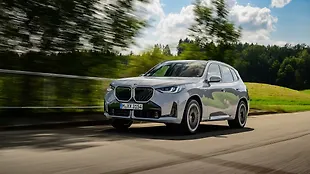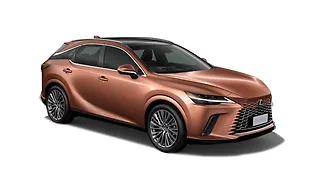Why would I buy it?
- Massive presence
- Huge cabin space
- Long-distance cruising ability
Why would I avoid it?
- Cabin quality
- Feature list
What is it?

Lexus’ flagship SUV has finally come to India in a new generation at Rs. 2.82 crore (ex-showroom, at the time of doing this drive). It’s the largest and the most expensive Lexus model that you can buy in India. Just once glance at the LX and you know that it’s all about the presence. Up front, the massive chrome grille is definitely in your face. In fact, in the image here, you can see me standing next to the car in proportion to the size of the grille.

Its 5.1-metre length is most visible when you look at it in profile, with large overhangs at both ends for that full-on boxy SUV stance. In fact, this is one of the few places on the outside where the LX’s Land Cruiser origins are very much visible. This is not a bad thing at all considering the reputation of the LC family of vehicles. While the front is loud and shiny, the rear feels a bit more ‘subtle’ but is still easily recognisable as the Lexus LX.
Is the cabin of the Lexus LX500d any good?

The cabin is huge and there’s no doubt about that, with more than enough space inside for four people to have their own business-class-like seating experience. There are no issues with headroom, shoulder room, or even legroom. But the floor is high so the under-thigh space is, for the lack of a better term, acceptable only, especially in the second row.

Then, the materials used to spec out the cabin are of high quality and of a pedigree that you expect when paying this kind of money for a car. Everything feels nice to touch and is shiny in all the right places but the cabin lacks a certain extra oomph that LX’s rivals do quite nicely, especially when you look at the cars from Bentley, Mercedes-Benz, and Range Rover.

Some of this is down to the fact that despite the use of high-quality materials, the cabin’s layout still looks very much like a top-spec version of the Toyota Land Cruiser. This is evident in the layout of the centre console and the positioning of the steering wheel. The Lexus LFA-inspired instrument cluster might have looked space age at one point but today, with rivals offering HD quality clusters with fancy graphics and massive amounts of information, this one feels a bit lacking. The interface on the touchscreen is bare and the only major highlight is inbuilt navigation. Moreover, it encourages you to quickly mirror your smart device wirelessly and carry on from that point onwards.

You get some decent kit in the back as well in the form of dual screens, individual climate zones, and a centre armrest with dual cup holders. As we said earlier, space is not an issue at all for two people but if you do bring in a third one, they will have to contend with a transmission tunnel and central AC vents. While globally you can have the LX with three rows, India only gets it as a two-row vehicle. That means with the rear seats folded down, the cabin is massive, wide, and tall, but with a high loading lip.
Is the Lexus LX500d any good to drive?

If it is a large car, it has to be a large engine right? Would you want it any other way? Powering this behemoth is a V6 turbo diesel producing 304bhp and 700Nm. A 10-speed automatic does transmission duties along with a very comprehensive 4WD off-road package lifted straight from the Land Cruiser. In this age of hybrids and EVs, this powertrain really stands out of place but that’s also its appeal in the larger scheme of things.

Let’s get one thing out of the way, the LX’s large size and dynamics make it quite an elephant to handle, with significant body roll even at any remotely hard turn. If you dial in the Sport mode, it’s not much of an improvement either. The massive turning radius and four turns to go from lock to lock aren’t exactly confidence-inspiring but that’s also due to the size of the car. It’s one of those vehicles that has no way of masking its size and it's best you accept the girth and tread with caution if the going gets twisty. In the city, if you get behind the wheel, then judging the edges of the car is pretty easy as it is quite high up and you get a 360-degree camera which helps things massively. Another place where it shines is ride quality. The massive ground clearance and huge tyres mean you can drive over speed breakers (smaller ones at least), potholes, and ruts without taking your foot off the gas and feeling them disappear under the wheel like the road was flat.

The large size also poses a strange problem in a country like India. That is, to make a U-turn or right turn at a signal or crossing, you have to go wide instead of being in the rightmost lane. This becomes an issue if you have a vehicle beside you that plans to go straight. To be honest, it’s more of an issue with the car’s size but it is something you should be prepared to face if you are going to buy a car like the LX500d. However, for the most, in India at least, most LX buyers will use the car in chauffeur-driven mode and thus filtering through traffic and finding parking will be left to the driver.

What it lacks in dynamics, the LX more than makes up for it with pure grunt and straight-line cruising ability. With 700Nm, a potent 10-speed automatic, and an 80-litre fuel tank, you can go large distances without much of a struggle. An experience that never gets old is when you mash the throttle (especially in the Sport mode) and the back of the car hunkers down before setting off in a blaze of diesel glory, hitting the 100kmph a lot faster than you would expect!
Should you buy the Lexus LX500d?

If cabin space, cruising ability, and road presence are what you want, the LX can be on your radar. It can also be a car that’s in your view if you like to sit in the front passenger seat and call the shots for whatever is going on. However, the cabin doesn’t feel special and like we said, it lacks the extra finesse that comes with cars from its rivals in Germany and UK. The LX500d, at the time of writing this review, was priced at Rs. 2.82 crore (ex-showroom). It takes on the likes of the Range Rover, Mercedes Maybach GLS, and the Bentley Bentayga.
Photography: Kaustubh Gandhi



































